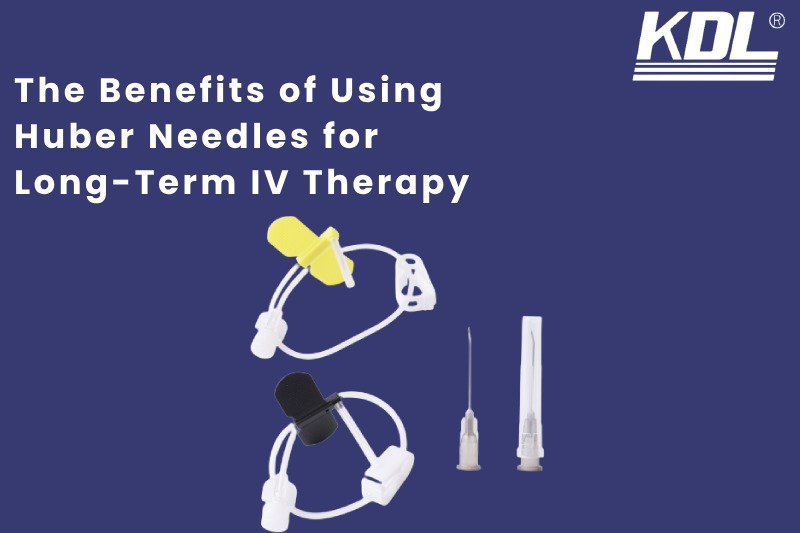
In the intricate world of modern medicine, the delivery of intravenous (IV) therapy has emerged as a pivotal component of long-term treatment regimens. One of the unsung heroes in this realm is the Huber needles – a medical device that may not be as familiar as the stethoscope but is equally significant. This article dives into the advantages of using Huber needles for long-term IV therapy, shedding light on their impact in enhancing patient care and medical outcomes.
What are Huber needles?
Huber needle are a type of specialized needle used in medical procedures, particularly for patients who require long-term intravenous access. These needles are specifically designed for accessing implanted ports or vascular access devices, such as central venous catheters or ports that are implanted beneath the skin. They are commonly used in oncology, hematology, and for patients who require frequent intravenous treatments.
The design of a Huber needle is distinct from standard needles used for injections. They have a non-coring tip, which means they’re crafted to puncture the skin without coring or cutting a plug of tissue upon entry or withdrawal. This design helps minimize damage to the septum of the port and reduces the risk of needle-induced septum damage or fragmentation.
These needles have a winged base or grip for easier handling and stabilization during insertion and removal. Additionally, they come in various gauges and lengths to accommodate different patient needs and clinical requirements.
Application of huber needle
A Huber needle is a type of specialized needle designed for accessing ports implanted beneath the skin for long-term intravenous (IV) therapy. It’s mainly used for patients who require frequent or continuous access to their bloodstream, such as those undergoing chemotherapy, receiving parenteral nutrition, or managing certain medical conditions that necessitate long-term IV treatment.
Some specific applications of the Huber needles
- Chemotherapy: Cancer patients often require frequent intravenous chemotherapy. A Huber needle is used to access the implanted port, providing a stable and reliable way to deliver medications.
- Long-term medication administration: For patients who require frequent or ongoing medication administration, such as antibiotics or pain management, a Huber needle helps in accessing the port without causing damage to veins.
- Parenteral Nutrition: Some patients unable to consume food by mouth may require parenteral nutrition, which is delivered intravenously. The Huber needle provides a means to access the port for such nutritional support.
- Hematology or blood-related treatments: Patients requiring regular blood transfusions or certain blood-related treatments may need long-term venous access. The Huber needle can be used to access their ports for these procedures.
- Fluid and Blood Product Administration: In critical care situations or in hospital settings where patients need frequent blood products, fluids, or medications, a Huber needle can provide reliable access to the port for delivery.
The design of the Huber needle reduces the risk of damage to the port, enhances patient comfort during needle insertion, and ensures stability during treatment. It typically has a non-coring, beveled tip to penetrate the port septum without damaging it, and a 90-degree angle to facilitate comfortable and secure placement without causing discomfort or dislodgments.
Benefits of Huber Needles For IV Therapy
Enhanced Patient Comfort and Reduced Pain
The journey through long-term IV therapy can be arduous, but the right tools can make it more bearable. Huber needles, with their unique design and construction, are tailored to reduce patient discomfort during needle insertion. Unlike standard needles, Huber needles minimize tissue trauma, leading to a more pleasant experience for patients. This improved comfort can play a crucial role in patient compliance with their treatment plans.
Minimized Risk of Infiltration and Extravasation
Infiltration and extravasation are words not commonly heard outside the medical community, but their implications can be severe. Huber needles offer a securement mechanism that significantly reduces the chances of these complications. Understanding the terms, infiltration and extravasation, is crucial to appreciate the importance of Huber needles in minimizing these risks and their potentially devastating consequences.
Prolonged Catheter Lifespan
Catheter replacement can be a logistical challenge and an additional source of discomfort for patients. The lifespan of a catheter greatly influences the frequency of replacements. Huber needles have the potential to extend the life of catheters, thereby reducing the hassle and discomfort associated with catheter changes.
Precise Medication Delivery
In the world of medicine, precision is paramount, particularly when it comes to drug administration. The stability and precision of Huber needles ensure that medication is delivered accurately, promoting optimal treatment outcomes. This is not just a matter of convenience but a critical aspect of patient well-being.
Lower Infection Risk
Infection control is a top priority in healthcare, especially when dealing with long-term IV therapy. Huber needles contribute significantly to infection prevention. It playing a vital role in improving healthcare economics by reducing the costs associated with treating infections.
Cost-Effective Long-Term Therapy
Huber needles, by contributing to cost savings through various mechanisms. It enable the healthcare system to provide high-quality care while balancing budget constraints effectively.
Wide Range of Applications
Versatility is a hallmark of excellence in any field, and the same applies to medical devices. Huber needles find applications in diverse medical fields, making them a go-to solution for treating chronic conditions and critical illnesses. Their ability to cater to a wide range of needs is a testament to their effectiveness.
Healthcare Professional Endorsement
What do healthcare professionals have to say about Huber needle? Their insights and experiences provide valuable endorsements for these medical devices. Real-life case studies show how practitioners view the importance of Huber needle in the realm of long-term IV therapy.
Conclusion
In conclusion the benefits of using Huber needle for long-term IV therapy cannot be overstated. From enhancing patient comfort to minimizing complications and reducing costs, these medical devices are an invaluable asset to the healthcare industry. By encouraging their adoption, we pave the way for a future of improved patient care through advanced medical technologies.

